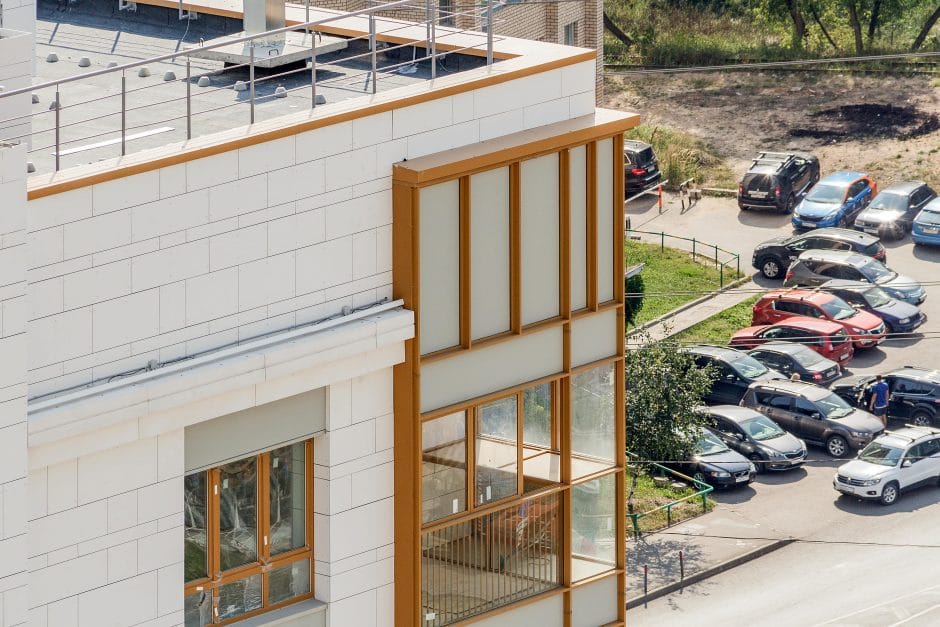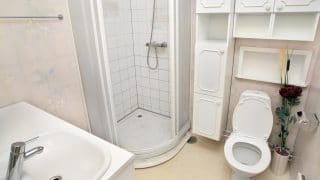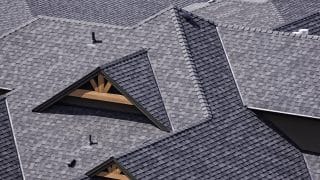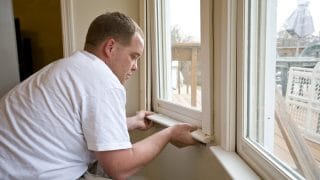
The cost and effort of new construction can easily be spoiled if water penetration promotes rot and mold in your new walls. You can avoid such headaches by constructing a simple but effective rainscreen system as part of your building’s exterior walls.
What is a rainscreen?
Rainscreen wall systems protect buildings from bulk water intrusion. They essentially serve as building envelopes, creating a tiny wall cavity that separates a building’s wall assembly from the elements. The small air pocket will help wick moisture away from the building and spare it from the damage that ensues when water sits in your walls for weeks and months at a time.
Building rainscreens is part of the overall exterior wall construction. They add almost nothing to the overall footprint of your structure, but they do require a tiny air cavity between their exterior cladding and the main walls of the building. This air space provides exterior insulation, and it also allows moisture to escape from the top and bottom of the structure. You can also have a rainscreen that only lets moisture escape through the bottom, but a gap at both the top and bottom makes the overall system more pressure equalized.
The 5 components that make rainscreens work
A rainscreen serves three primary purposes: It blocks precipitation and wind, it allows moisture to drain away from your exterior walls without penetrating the main wall assembly of your house, and it provides a degree of exterior insulation. They do this by combining five main structural components:
- Water-resistant barrier. A WRB is a special moisture-resistant wrap that is sold under brand names like Tyvek, Typar, and Blueskin. They stop water from flooding into your home.
- Furring strips. These are thin wood strips that support your rainscreen and provide an air cavity between your WRP and the exterior cladding.
- Venting material. Venting material is the principal component of your rainscreen wall system. It attaches to your furring strips and serves as a capillary break to whisk moisture upward or downward and away from your wall assembly. It is manufactured by brands like Owens Corning and Cor-a-Vent.
- Exterior cladding: Exterior cladding refers to the exterior wall that is exposed to the elements. It can be made from brick, stone, stucco, and various types of siding (including vinyl, wood, and fiber cement).
- Trim: Trim refers to exterior finishes that largely serve an aesthetic purpose, as opposed to a functional one. Some trim, like horizontal and vertical beams, serves both purposes simultaneously.
When rain and snow hit the external cladding of your house, most will be blocked and deflected to the ground. Some moisture may penetrate, and this is where the rainscreen system does its work. The furring strips and venting material beneath that exterior wall will create a very small air cavity that keeps the moisture from settling into your walls and causing long-term rot and mold. Instead, via a mixture of gravity and capillary action, the moisture is funneled either up or down so that it does not sit in your walls, waiting to cause problems down the line.
Advantages of rainscreens
Rainscreens are popular with builders and homeowners for three key reasons.
The cost and effort of new construction can easily be spoiled if water penetration promotes rot and mold in your new walls. You can avoid such headaches by constructing a simple but effective rainscreen system as part of your building’s exterior walls.
What is a rainscreen?
Rainscreen wall systems protect buildings from bulk water intrusion. They essentially serve as building envelopes, creating a tiny wall cavity that separates a building’s wall assembly from the elements. The small air pocket will help wick moisture away from the building and spare it from the damage that ensues when water sits in your walls for weeks and months at a time.
Building rainscreens is part of the overall exterior wall construction. They add almost nothing to the overall footprint of your structure, but they do require a tiny air cavity between their exterior cladding and the main walls of the building. This air space provides exterior insulation, and it also allows moisture to escape from the top and bottom of the structure. You can also have a rainscreen that only lets moisture escape through the bottom, but a gap at both the top and bottom makes the overall system more pressure equalized.
The 5 components that make rainscreens work
A rainscreen serves three primary purposes: It blocks precipitation and wind, it allows moisture to drain away from your exterior walls without penetrating the main wall assembly of your house, and it provides a degree of exterior insulation. They do this by combining five main structural components:
- Water-resistant barrier. A WRB is a special moisture-resistant wrap that is sold under brand names like Tyvek, Typar, and Blueskin. They stop water from flooding into your home.
- Furring strips. These are thin wood strips that support your rainscreen and provide an air cavity between your WRP and the exterior cladding.
- Venting material. Venting material is the principal component of your rainscreen wall system. It attaches to your furring strips and serves as a capillary break to whisk moisture upward or downward and away from your wall assembly. It is manufactured by brands like Owens Corning and Cor-a-Vent.
- Exterior cladding: Exterior cladding refers to the exterior wall that is exposed to the elements. It can be made from brick, stone, stucco, and various types of siding (including vinyl, wood, and fiber cement).
- Trim: Trim refers to exterior finishes that largely serve an aesthetic purpose, as opposed to a functional one. Some trim, like horizontal and vertical beams, serves both purposes simultaneously.
When rain and snow hit the external cladding of your house, most will be blocked and deflected to the ground. Some moisture may penetrate, and this is where the rainscreen system does its work. The furring strips and venting material beneath that exterior wall will create a very small air cavity that keeps the moisture from settling into your walls and causing long-term rot and mold. Instead, via a mixture of gravity and capillary action, the moisture is funneled either up or down so that it does not sit in your walls, waiting to cause problems down the line.
Advantages of rainscreens
Rainscreens are popular with builders and homeowners for three key reasons.
- Protection against long-term damage. The point of a rainscreen isn’t simply to keep today’s rain from entering your house and getting your stuff wet. It’s to keep moisture from building up in your walls and causing long-term damage. By creating a small air space, you give water space to drip downward or evaporate upward and not penetrate the main walls of your house.
- Insulation. In addition to blocking water and wicking it away, rainscreens provide a degree of exterior insulation thanks to the air pockets they create. Just as wearing multiple layers can keep you warmer than a single heavy coat, having layers of wall can insulate your house better than one single thick wall.
- Affordable when added to a construction project. Rainscreens add very little overall cost to new construction. Depending upon your builder, expect to spend an extra one to two dollars per square foot. Yes, this will increase your budget, but the cost will be far less than what you might pay to replace entire walls damaged by long-standing moisture.
Disadvantages of rainscreens
Rainscreens provide obvious advantages once installed. Still, they do come with their set of drawbacks.
- Will not work with all wall surfaces. Rainscreens comport best with walls made of siding. They offer a less useful function with brick or stone walls. If the building is composed of large glass panels, a rainscreen will not even be possible.
- In some climates, they may not be worth the cost. Rainscreens add money to the cost of construction, and they will only pay for themselves if you live in a region where sustained water damage is a real concern. This makes them a good investment for those on the east coast or the Pacific Northwest, where there is a lot of rain. They may not be worth the cost in arid regions where there simply is not enough annual precipitation to put your home’s walls at serious risk.
- Not every builder has experience constructing rainscreens. Do not assume that all builders create rainscreens in their regular course of work. As directly to see if your builder has installed them in the past. Choose wisely because if improperly constructed, a rainscreen won’t do you any good at all.
MT Copeland offers video-based online classes that give you a foundation in construction fundamentals with real-world applications, like how house framing works. Classes include professionally produced videos taught by practicing craftspeople, and supplementary downloads like quizzes, blueprints, and other materials to help you master the skills.






